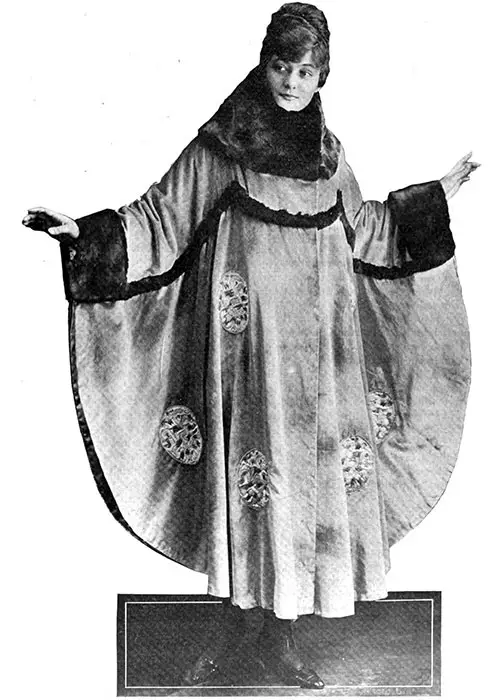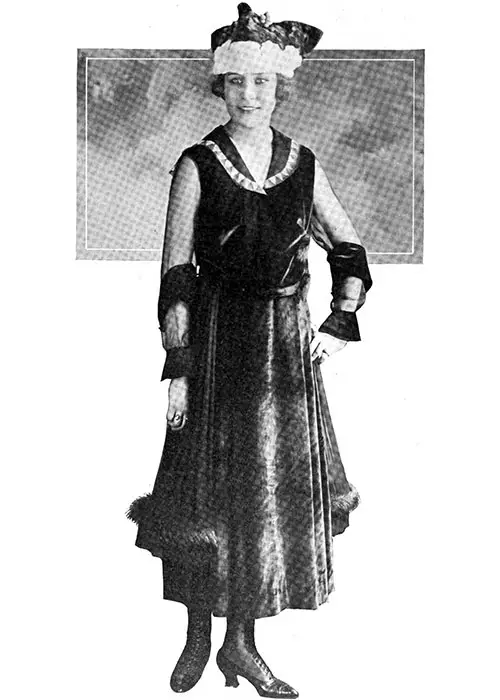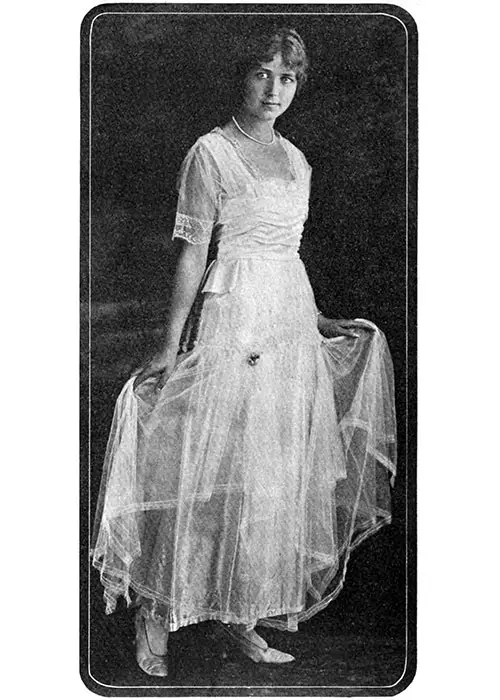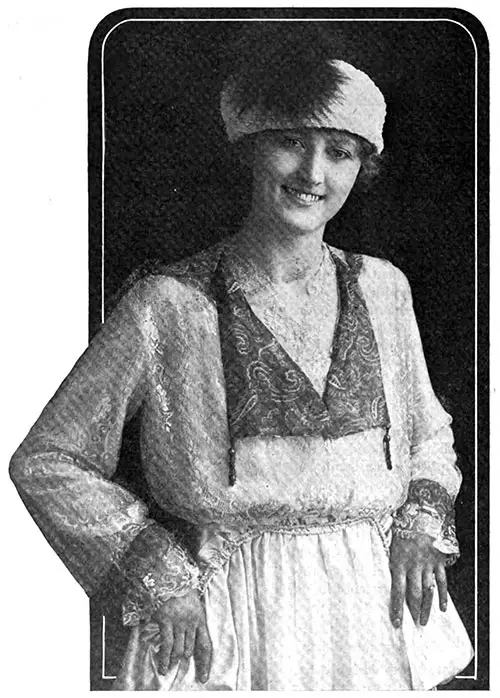Silk Fabrics in Fashion - 1916

Silk fabrics which are most talked about in the silk market today are satins, taffetas, Georgettes and crepe de chine. But there are others.
In fact, no buyer of silks can go far wrong in his purchases during the present season.
The Fashion Demand
Brocades, everyone knows, are in demand for both afternoon and evening costumes, as well as for evening wraps. These are in the all silk brocades, of either plain, two or three tone effects, and the tinsel brocades, which have been such a prominent feature of all collections of imported models. Even afternoon models are shown in gold and silver brocades.
It is hardly likely that American women will adopt tinsel brocades to any great extent for day wear. Therefore the all silk brocades are strongly indicated in both dark and light colors as substitutes for the more gorgeous as well as costly fabrics.
There are beautiful examples of these shown in a few domestic lines, both in the self-colored and the two and three tone combinations. However, the latter are produced in small quantity and are comparatively high priced.
It is self-colored brocades which will satisfy the taste and requirements of the majority of American women able to purchase such fabrics, and there will probably be a big development in the demand for them in the near future.
Tinsel Brocades
Retailers are showing a great variety of styles in fancy silks, silks in which tinsel and color figure largely. These point the way and are evidence of increased demand for plain silks.
Many of the fancy silks now being shown by the retailers while they will be bought to some extent for the construction of an entire garment will find their greater demand for ornamental purposes.
Ribbon Promotors
There has been a considerable effort on the part of ribbon manufacturers to exploit narrow silk fabrics. The plan was apparently all right in its conception, but it has been badly executed, as is proved by the fact that the demand for ribbons is no better today than it has been for some time.
It will probably be a surprise to the garment trade to learn that during the last year there has been a campaign on to increase the demand for ribbons.
That is evidence of the capacity of the organizers to rightly handle such a fashion campaign. To pass over the garment trade is to show how utterly incompetent are the promotors of any campaign which has to do with women's wear.
Perhaps the promotors were in this instance wise in their bluff. It is a foregone conclusion that they knew nothing of the importance nor the necessities and requirements of the garment trade. Had they known them they might possibly have built better.
As it is the garment trade never knew that ribbons might possibly be wanted, and therefore throughout the entire line of distributors they have been consigned to innocuous desuetude—harmless disuse.
In other words, ribbons are not used. There has been shown no good reason to use them. Therefore, the garment trade has not adopted them, and ribbon manufacturers have spent their good money in vain.
The so-called fashion campaign may therefore be regarded by the garment manufacturers as a joke if they ever knew of it. We had our weather eye open and the ribbon people couldn't convince the editor of the Fabric Section that there was any good and logical reason why a ribbon vogue should be boosted.
Oh, they tried, yes, they tried rather strenuously for twelve months or more. But the reply to such exertions was either silence or an article which showed how broad silks were more economical for trimming purposes than ribbons.
Economical Production

The production of garments must essentially be based on an economical foundation. Particularly is this so in the present era of high prices. It is also emphasized by the general fashion tendency towards greater simplicity of feminine attire.
Women are ready and willing to pay the price for worthy fabrics, also for fabrics of a novelty nature. But it is seldom that a woman is seen these days who overloads her garments with ornamentation.
There was a time, and not so many years ago at that, when silk was a luxury only. Today it is both a luxury and an economy. When you realize that is the viewpoint of the average woman then you will understand why there is such an increased demand for silk garments.
Silk manufacturers realized this fact some seven or eight years ago. Some of them set out to push the demand for better quality, pure dye silks. The results of these efforts have been the gradual elimination of the poorer qualities as well as the practical elimination of the overweighting of silks.
Weighted Silks
Some kinds of domestic silks are weighted to-day, but in the main they are kept within the limits of satisfactory wear. The discerning silk manufacturer has found it doesn't pay to overweight his silks.
His customers would come back at him every time a woman purchased a silk which did not give satisfactory wear. Not so with the foreigners. Some of the best of them continue to weight their silks to such a degree that it is literally impossible for them to prove satisfactory to the wearer.
Beneath the present trend towards piece dyed silks is very probably the fact that one year ago women who purchased some of the most fashionable of the imported silks of that season around $4.50 a yard found that the silk had cracked.
At the time, a test was made of some of these silks and the statement was made in these columns that domestic silks at the same wholesale price were far and away better value than the foreign ones.
Nevertheless, because some of the foreign silks were not up to the American standard, and because certain American manufacturers also failed to see the good business in maintaining the American standard, there has come a reversal of the fashion tendency as regards silk. Now the tendency is markedly towards the soft clinging quality.
Spring Silks
While silk manufacturers have been doing a good business on staple lines of silks for Spring there are few or any of them who are ready and willing to state just what the big demand for Spring will be.
Said one well known silk man the other day: "This is a period of watchful waiting with us. During the past week I have been studying the situation." And how has he studied it?
Just as some of the rest of us have been able to study it—through our entree to some of the more exclusive, the most successful of the establishments which cater to the best trade.
It is not everyone who has the entree to such concerns, because it is not everyone who knows when and how and what to say regarding the ideas gleaned from such firms.
It is no violation of confidence to say for the benefit of our readers that meritorious quality will be an essential requisite in the distribution of silk merchandise for Spring.
Women will be ready and able to pay the higher price for silk garments, provided they are made of silks of meritorious quality, also provided they are made of the new silks.
Spring Demand Indicated
And what are the new silks to be? Well, while the writer has not seen a single line of Spring silks it is one safe bet that good quality and novel designs in printed silks will hold a prominent place in Spring distribution.
Printed silks will be wanted for the construction of both the day and evening costume as well as for the lining of the tailored suit.
Mark you, Mr. Coat and Suit Manufacturer, there is a big business going to be done on lining silks of a fancy nature and also on plain satins of a contrasting color.
In the former you can quite well exercise your own judgment as to design and color; in the latter you must know what are the colors which will be most used by the waist manufacturers for their early Spring lines.
For there are certain indications which point to a harmony of color in plain linings between the waist and the coat lining. Of course, this indication is confined entirely to the suit.
Lining Silks
Since suit manufacturers have placed their advance orders on cloths to a considerable extent on what for a better name may be called drab colors—such as muddy tans and beiges and cold grays, it is essential that linings for such suits should be of a decidedly lively nature. Therefore yellow and rose and to a limited extent pale green are indicated in plain silks.
These suits must be so trimmed that they will counter act the somewhat depressing air of their color. For this purpose it is essential that collars and cuffs should be of a lively nature.
There would seem to be a good possibility for trimming silks of a somewhat heavy nature for this purpose, such as the heavier corded weaves and the rough woven shantungs.
Collars and cuffs made of brilliant shades of these silks could be bound with the material of which the suit is constructed, while the lining might be of a matching or somewhat lighter shade of satin. Such a thing has never been done, but that is no good reason why it should not be done.
Of course, you can extend the lining of the coat so as to face the collar and cuffs. This is not exactly a new idea, yet is well adapted for the coming season, particularly if you make a good selection of printed lining silks. This would give the wearer the opportunity for considerable variety in her costume.
She could select waists of various colors which would harmonize with the colors in the linings or she could equally well wear a white waist with her suit.
Lining silks are not such an important item of consideration for the coat manufacturer in the Spring as they are in the Fall season.
The majority of coats in the Spring season are made without linings. Nevertheless, lining silks require a certain amount of thought from the coat manufacturer. This is especially true in the better priced merchandise and in evening wraps.
In such lines printed silks will take the place of the metal brocades so much used during the Winter season. Also there will be a considerable use of plain satins in the soft and more vivid shades.
For Street Dresses

But printed silks will find their greatest use for the construction of the late Spring and Summer dress for day wear. It is long since we have had any decided demand for printed silks for street use, but it looks now as though there would be a big demand for them for such purposes.
In the early season it will be the dark street shades ornamented with white or light colors, which will have the call. Then will come the demand for black or blue designs on white grounds.
Also your early orders on silks should include the fair quantity of wash silks, not only for the construction of the waist, but to a very considerable extent those which are suitable for the construction of the dress.
The present tendency in fashions, as also the merchandise conditions, favors a strong development of wash silks for the construction of mid-summer gowns, whether they be intended for day or evening purposes.
There is a good and almost undeveloped field for any dress manufacturer who can and will produce simple styles in wash silk dresses.
Guimpes and collars of embroidered nainsook or organdie may be added to some of these, but the majority of them can wisely be entirely self-trimmed, hence leaving it to the wearer to select the neckwear she prefers.
The general tendency shown in the latest Paris models towards straight line effects in suits and dresses indicates a strong demand in the early Spring for soft silks for the construction of both suits and dresses. These may be wisely selected in plain colors in both dark and medium shades.
Satin surfaced goods look good for such purposes. These may in some instances be combined with cloth for the early season. Then there are the crepes, such as crepe de chine and crepe meteore, which may be combined with a somewhat heavier silk for both the early and the mid-season.
Transparent Silks Strong

Crepe Georgette goes on its triumphant way. Some there are who are even now predicting a lessening in the demand for crepe Georgette. But don't you believe it. Crepe Georgette takes a considerable amount of time to produce, women have tried it out and found it admirably suited for many purposes.
And since crepe Georgette is scarce and high it is a good bet that it will be one of the most wanted fabrics the coming season and will bring in its train a demand for all silk fabrics of a transparent nature.
Transparent silks will be wanted in both light and dark colors. They will be wanted in dark colors not only for the construction of sleeves, but of entire costumes trimmed with a heavier silk.
Do you realize that some of the smartest women adopted the dark colored crepe Georgette, chiffon or voile dress for street wear during June, July and August this year?
These materials have proved satisfactory for such purposes and the same women, also a multitude of imitators are certain to want costumes of these materials suitable for street wear the Spring and Summer of 1917.
In many cases the costume in dark colors of these transparent fabrics means a small cape of the same material as that with which the transparent material is trimmed.
Also the coming vogue of sheer silk fabrics means an increased demand for the silk petticoat of matching color as well as of white. There is a big field for the development of the colored taffeta petticoat the coming season.
Make no mistake about that—it is the taffeta petticoat which looms up big, though if taffeta prove too high priced then undoubtedly messaline will have a good innings.
“Silk Fabrics,” in The American Cloak and Suit Review: Fabric Section, New York: John M. O’Connor & Company, Publishers, Vol. XII, No. 4, October 1916, p. 201-205

